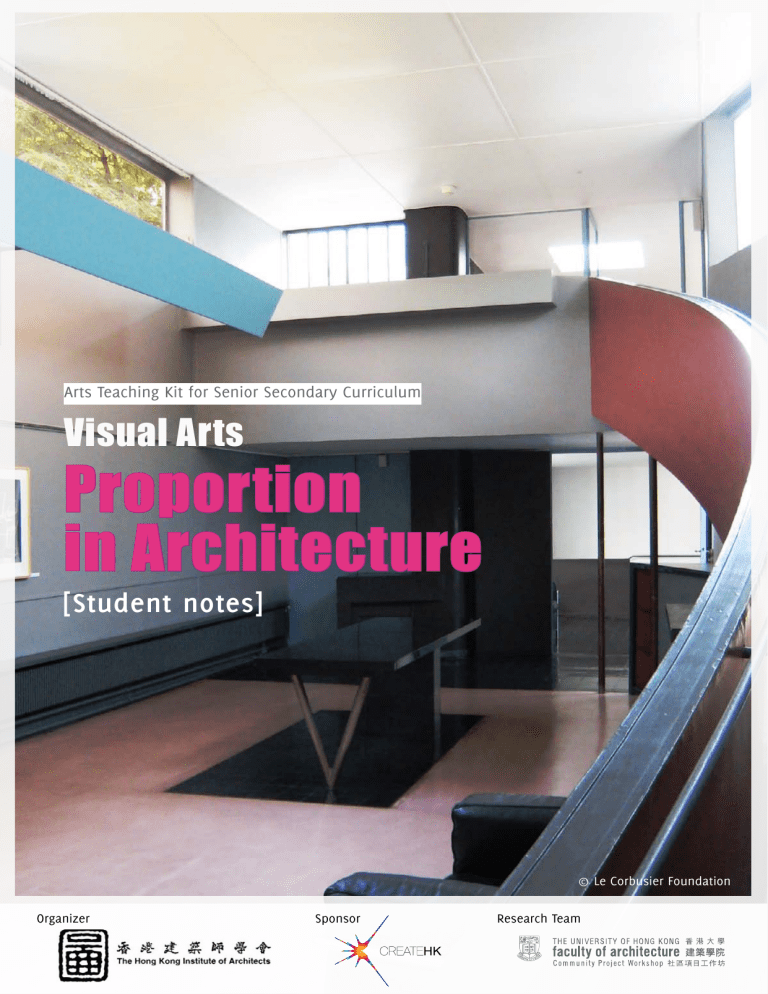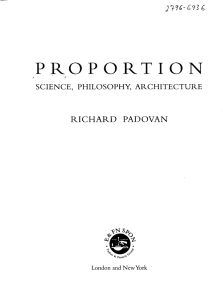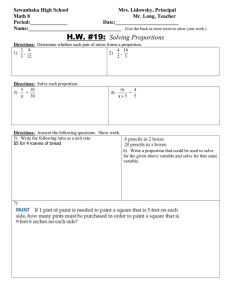
Arts Teaching Kit for Senior Secondary Curriculum Visual Arts Proportion in Architecture [Student notes] © Le Corbusier Foundation Organizer Sponsor Research Team Contents Preamble Learning plan i Lesson 1: Proportion in Architecture 1.1 What is Proportion in Architecture? 1.2 The Aesthetic Ratio in Art and Architecture 01 02 1.2.1 The Golden Ratio in Art and Architecture 02 1.2.2 Case Study 1 - Ancient Greek Temples 04 Exercise 1 — Finding the Golden Ratio in Architecture 1.2.3 Le Corbusier’s Modulor System 06 08 1.2.4 Case Study 2 — Unité d’Habitation 09 Exercise 2 - Applying Proportion to Art and Furniture Design 11 Summary, Key words and Further reading 12 Disclaimer Create Hong Kong of the Government of the Hong Kong Special Administrative Region provides funding support to the project only, and does not otherwise take part in the project. Any opinions, findings, conclusions or recommendations expressed in these materials/events (or by members of the project team) do not reflect the views of the Government of the Hong Kong Special Administrative Region. © 2012 Hong Kong Institute of Architects Arts | Proportion in Architecture Topic 06 Proportion in Architecture Major Teaching Areas Interdisciplinary Teaching Areas Visual Arts Design and Technology Arts Appreciation and Criticism in Context Strand 1 Design and Innovation • Formal knowledge • Knowledge of History and Ways of Seeing Learning objectives • To learn how proportion is applied in ancient architecture and contemporary architecture • To apply appropriate proportion in different types of three-dimensional arts Learning plan Lesson Lesson 1 Contents • 1.1 Discuss the importance of proportion in good architecture Proportion in architecture • 1.2 Evaluate common proportions adopted in art and architecture Arts | Proportion in Architecture • To understand how proportion contributes to good architecture • Apply appropriate proportion in architecture through exercise i Lesson 1 Proportion in Architecture 1.1 What is Proportion in Architecture? Introduction - proportion as the expression of architecture The English author Henry Wotton translated ‘de Architectura’, which was written by Roman architect Vitruvius in 1624, and interpreted Vitruvius’ three conditions of a good building to be commodity (usefulness), firmness (solidity or strength) and delight (beauty). Proportion plays an important role in all three, as it provides guidelines for laying out useful spaces, for designing structural systems, and for creating an aesthetically pleasing environment. The proportions of a space can dramatically change how visitors feel in it, and the proportions of a facade design can affect whether a building appears welcoming threatening, or impressive. Arts | Proportion in Architecture p The tall vertical space in York Minster p The wide passage/ common space of Ewha Womans University, South Korea [Discussion] 1 How would you describe the two spaces above? 2 What kind of activities will you suggest to be held at the two places? 3 How does proportion affect the sense of place? 01 [Discussion] 1 How do the spaces below satisfy/dissatisfy the three conditions of a good building? 2 Can scale and proportion in art and architecture be perceived in similar ways? p p Children’s playhouse 1.2 The Aesthetic Ratio in Art and Architecture 1.2.1 The Golden Ratio in Art and Architecture The golden ratio (also called the golden rectangle) is a proportioning system that governs the relationship of smaller parts to the whole. It has long been believed to produce some of the most aesthetically pleasing shapes in nature, and as such has been used in many works of art and architecture. The ratio is AB:BC=BC:AC=1:1.618. C B Arts | Proportion in Architecture Caged home in Hong Kong © Society for Community Organization A B C p The Golden Rectangle diagram © Helen Fan 02 ©The Museum of Modern Art/ Scala, Florence The golden ratio is widely applied in ancient art, classical paintings, modern paintings and contemporary graphic design. 3 Arts | Proportion in Architecture 1 2 4 1: ‘Mona Lisa’ by Leonardo da Vinci © Michael Paukner 2: Stamp design by Stephan Bundi © Museum of Communication, Berne 3: ‘Broadway Boogie Woogie’ by Piet Mondrian, 1942-43 © 2012 Mondrian/Holtzman Trust c/o HCR International USA 4:Fragment of an inscription on a tombstone from Chieti, National Museum, Rome © National Archeology Museum of Naples, Italy 03 ‘ Without symmetry and proportion there can be no principles in the design of any temple; that is, if there is no precise relation between its members, as in the case of those of a well-shaped man. - Marcus Vitruvius Pollio, Book III, Chapter 1 ’ Marcus Vitruvius Pollio, a Roman architect, wrote in his Ten Books on Architecture on the importance of symmetry and proportion. In his language, symmetry means harmony in architectural design, while proportion is the relationship of different parts of building. Vitruvius further suggested that • buildings should scale down to dimensions humans can relate to, • and all buildings should be developed from a standard module (i.e. dimensions in the building should be proportional to the set module). 1.2.2 Case Study 1 p Arts | Proportion in Architecture Ancient Greek temples Location: Greece and Italy Analysis of the Temple of Neptune, Paestum, Italy, from “Rhythm and Proportion in Lettering” by Walter Kaech, 1956 © National Archeology Museum of Naples, Italy The temple was generated from Golden ratio AB:BC=AC:BC Façade in Golden Ratio • The principles of the Golden Ratio are visible in the façades of ancient Greek temples AB:BC=AC:BC=1:1.618. • Because of the Golden Ratio’s relationship to nature, it was used in building temples as a sign of appreciation to gods. • Strength - The height of the pediment (top triangular component) is proportional to the height of the column so as to maintain structural stability. • Beauty - Entablature (roof slab) is carefully subdivided into structural element (lintel) and decorative element (frieze). 04 u Diagram of proportioning systems in Doric and Ionic orders, illustrated from William Ware’s analysis of the classical orders d = Diameter of the column shaft, i.e the standard module in Greek orders q Details on a Doric column Triglyph=0.5d Dentil=0.25d Doric Doric Ionic Arts | Proportion in Architecture Evolution of the Greek Orders In ancient Greek architecture, the Greek Orders were the guidelines of building projects. The three Greek Orders were: Doric Order — the starting point of the Greek orders and the simplest form. Ionic Order — an order evolved from Doric order, the mature form of the Greek Orders and the peak of style. Corinthian Order - an over-developed compound style with leaf-like details made of stone. p Doric Order p Ionic Order p Corinthian Order The Greek Orders - standard module proportional to ideal human forms • Every building element follows an ‘order’, and each order is meant to mimic ideal human forms. • The Greek orders are proportionally related to Golden ratio and the proportion of an ideal human form. • In Vitruvius’s book, the classic orders (Doric, Ionic and Corinthian), have their own proportioning systems. • Each element of ancient Greek temples is proportional to a module. In the classical order. The diameter of the column shaft at the base is often set as a module. An Ionic column is a representation of an ideal female proportion while the Doric order is a representation of an ideal male proportion. In the diagram, the two columns are illustrated with the same module. 05 [Exercise 1] Finding the Golden Ratio in Architecture This is Hong Kong’s Old Supreme Court building. Can you see how the building is designed using the golden ratio? Arts | Proportion in Architecture p Elevation of the Old Supreme Court building 06 © Peter Randall p Examples of applying Golden Ratio — (Left) Old Supreme Court building, Hong Kong follows a classical proportioning system to reflect its sovereignty. (Right) The spiral roof of The Core, the educational centre in the Eden’s Project, UK, is generated from Golden Rectangle. [Discussion] 1 Is Golden ratio always applicable to both art and architecture? What are its limitations? Strengths Limitations Arts | Proportion in Architecture q Examples of using dynamic form — (left) Architect Daniel Libeskind used an asymmetrical and dynamic form in the Run Run Shaw Creative Media Centre in Hong Kong. (right) Architect Frank Gehry’s signature sculptural building envelope at the Walt Disney Concert Hall in Los Angeles. © Mike Hui 07 1.2.3 Le Corbusier’s Modulor System p Modulor diagram according to different postures by Le Corbusier, 1954 © Le Corbusier Foundation Arts | Proportion in Architecture The Modulor system by Le Corbusier The Modulor system is the most famous standard of proportions used in architecture. It is a scale of measurements and proportions of the human body devised by Swiss architect Le Corbusier (1887–1965). Le Corbusier bridged the relationship between the Imperial System (e.g. inch and feet) and the Metric System (e.g. millimetre and metre) by providing a system which takes the heights and proportions of the human form as a universal standard. The system is based on the human body in different gestures. Le Corbusier applied the system in his drawings, furniture design and architecture. uq Le Corbusier Chaise Lounge Chair LC4. The “wave” in this chair mirrors the curves of the body making it extremely comfortable and ergonomic. For example, the height of the seating is made 430 mm, the dimension of which is taken from the sitting posture of the Modulor man. © Le Corbusier Fundation 840 430 1600 570 © Hen Fan 08 1.2.4 Case Study 2 The free façade of Unite d´Habitation is formed by a carefully orchestrated pattern of single-and doubleheight balconies generated from 15 different types of living spaces and public, communal spaces, in which dimensions are determined by the Modulor system. © Hen Fan This residential project was Le Corbusier’s first opportunity to implement the Modulor system. The Unite d´Habitation in Marseille was meant to provide a prototype for other urban housing projects. The building had a standard module of 2.26 m (Modulor man’s dimension). Four other versions were built in different locations afterwards, but they were changed from Le Corbusier’s concept for reasons of cost or political compromise. The Modulor system provides: Arts | Proportion in Architecture Unité d’Habitation by Le Corbusier Year of completion: 1952 Location: Marseille, France (Others are located in Nantes-Rezé, Berlin, Briey-en-Forêt and Firminy) p • usefulness by proportioning the plan, section and elevations of the building (e.g. corridor width, storey height and bay distance), the brise-soleil (sun-shading device) and furniture units to human activities; • strength by spacing the supporting columns in order; • beauty in the façade by introducing rhythm. q p Openings, seating and structural elements on the internal ‘shopping street’ are governed by the Modulor system. Elevation of Unite d´Habitation in Marseille 09 Challenges In Berlin, Le Corbusier was forced to abandon the proportions given by the Modulor system due to the difficult relations with employees and the incompatibility of German building regulations. The storey height of the Unité was increased by 1m. Le Corbusier was upset and ended up resigning from work. [Discussion] The Modulor system was designed by Le Corbusier as a universal standard. 1 What is the aesthetic value of the Modulor system? (Rhythm? Pattern? Spatial quality?) Arts | Proportion in Architecture Le Corbusier wished to apply the Modulor system in the project of the Unité d’Habitation in other locations. The Unité in Firminy was built under a tight budget and restrictive regulations from HLM (Habitations à Loyer Modéré, French Social Housing authorities). He was required to translate the Modulor system in yards. 2 Is the system applicable to all types of buildings? 3 Is there any other scale we need to consider when designing a building? 4 How can we apply good proportions in architecture? p Transformation of Modulor system for a nursery school designed by a French student Vassent Garaud © Marion Vassent-Garaud, French 10 [Exercise 2] Applying Proportion to Art and Furniture Design Create a Modulor system for your classmates, friends or family members. Design a piece of furniture that is suitable for their needs. Example: Applying proportion in art / furniture design The outdoor module, ‘Assembled Topology’ designed by Douglas Ho from SLHO, can perform either as a piece of public art or outdoor furniture in the Quarry Bay Park. The pragmatic design of module encourages people to sit and lean on in different gestures, as well as for children to play. It can serve as a single piece or in different configurations. Arts | Proportion in Architecture p People gathering around the art / furniture piece, ‘Assembled Topology’. © SLHO & Associates Ltd. Bottom: Repeating modules of the design (left) are used as a playground for children and as an outdoor furniture for adults (right). 11 Summary 1. Proportion is important as the order of architecture for usefulness, strength and beauty. 2. The golden ratio, a common relationship of scale in nature, introduces order and creates harmony in visual art and architecture. 3. Vitruvius suggested that building dimensions should relate to human scale, and a standard module should be developed. 4. Le Corbusier elaborated the golden ratio and developed the Modulor system as a universal standard. 5. A good architecture should employ appropriate proportions for its functions and its particular users (usefulness), and should fulfil structural requirements (strength) and provide aesthetically pleasing order (beauty). Key words Proportion Scale Golden Ratio Modulor system Further reading 1. Bangs, Herbert. The return of sacred architecture: the golden ratio and the end of modernism. England: Inner Traditions. 2006. 2. Benton, Tim. ‘Le Corbusier (Charles-Édouard Jeanneret)’. Oxford university Press [Online]. Available at: http: / / www. moma.or g/m/ex plor e/collectio n/ar t _ t er m s /3426/0/1.ip ho ne_ ajax ?k las s =ar t is t 3. Frings, Marcus. 2002. ‘The Golden Section in Architectural Theory.’ Nexus Network Journal vol. 4 no. 1. 2002. pp. 9-32. [Online] Available at: htt p ://w w w.mar cus -fring s.d e/t ex t -nnj.ht m 4. Kaech, Walter. Rhythm And Proportion In Lettering. Olten: Walter-Verlag. 2956. 5. Le Corbusier. The modulor : a harmonious measure to the human scale, universally applicable to architecture and mechanics. London: Faber and Faber. 1954. 6. Neufert, Ernst. Bauentwurfslehre. Berlin: Bauwelt-Verlag. 1936. 7. Vitruvius. Ten Books on Architecture. Massachusetts: Harvard University Press. 1914. 8. Ware, William R. The American Vignola: a guide to the making of classical architecture. USA: Dover Publications. 1994. © Le Corbusier Foundation Organizer Sponsor Research Team Arts | Proportion in Architecture Greek orders


